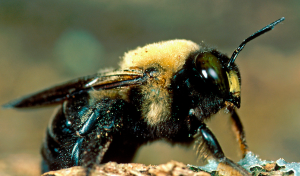Carpenter bee: Difference between revisions
No edit summary |
No edit summary |
||
| Line 1: | Line 1: | ||
== Overview == | == Overview == | ||
If you ever wonder if there were bees near wood structures around your home, chances are those are carpenter bees. They are large, solitary bees belonging to the genus Xylocopa. They get their name from the female bee because they bore into wood to create tunnels when they lay their eggs. | If you ever wonder if there were bees near wood structures around your home, chances are those are carpenter bees. They are large, solitary bees belonging to the genus Xylocopa. They get their name from the female bee because they bore into wood to create tunnels when they lay their eggs. | ||
{| class="wikitable" style="text-align:center; float:right; margin-right: 10px; | {| class="wikitable" style="text-align:center; float:right; margin-right: 10px; | ||
| Line 30: | Line 26: | ||
|- | |- | ||
|} | |} | ||
== Identification == | |||
They can range from 0.7 to 1 inches long. The thorax is covered with fuzzy yellow, orange, or white hairs. The abdomen is shiny black, The female has an entirely black head while the male has yellow or white markings. | |||
They closely resemble bumble bees; unlike carpenter bees, bumble bees' entire body is covered with hairs, and they are also social, living together in an underground nest. [2] | |||
== Life Cycle == | == Life Cycle == | ||
In April or May, the female carpenter bee searches for a good nesting site. She will reuse and expand on existing tunnels or bore her own [2]. At times, some carpenter bees will occupy the same piece of wood with nest galleries so close to each other. However, all carpenter bees behave independently of the other bees [2]. They can live IP to 3 years, and there can be one or two generations per year [3]. | In April or May, the female carpenter bee searches for a good nesting site. She will reuse and expand on existing tunnels or bore her own [2]. At times, some carpenter bees will occupy the same piece of wood with nest galleries so close to each other. However, all carpenter bees behave independently of the other bees [2]. They can live IP to 3 years, and there can be one or two generations per year [3]. | ||
Revision as of 21:23, 29 April 2025
Overview
If you ever wonder if there were bees near wood structures around your home, chances are those are carpenter bees. They are large, solitary bees belonging to the genus Xylocopa. They get their name from the female bee because they bore into wood to create tunnels when they lay their eggs.

| |
| Kingdom: | Animalia |
|---|---|
| Phylum: | Arthropoda |
| Class: | Insecta |
| Order: | Hymenoptera |
| Family: | Apidae |
| Genus: | Xylocopa |
Identification
They can range from 0.7 to 1 inches long. The thorax is covered with fuzzy yellow, orange, or white hairs. The abdomen is shiny black, The female has an entirely black head while the male has yellow or white markings. They closely resemble bumble bees; unlike carpenter bees, bumble bees' entire body is covered with hairs, and they are also social, living together in an underground nest. [2]
Life Cycle
In April or May, the female carpenter bee searches for a good nesting site. She will reuse and expand on existing tunnels or bore her own [2]. At times, some carpenter bees will occupy the same piece of wood with nest galleries so close to each other. However, all carpenter bees behave independently of the other bees [2]. They can live IP to 3 years, and there can be one or two generations per year [3].